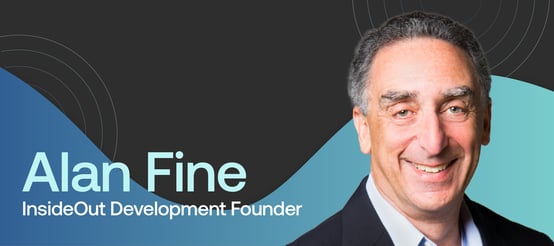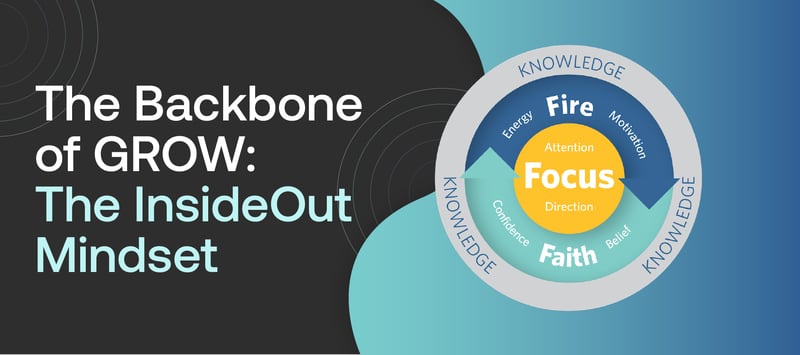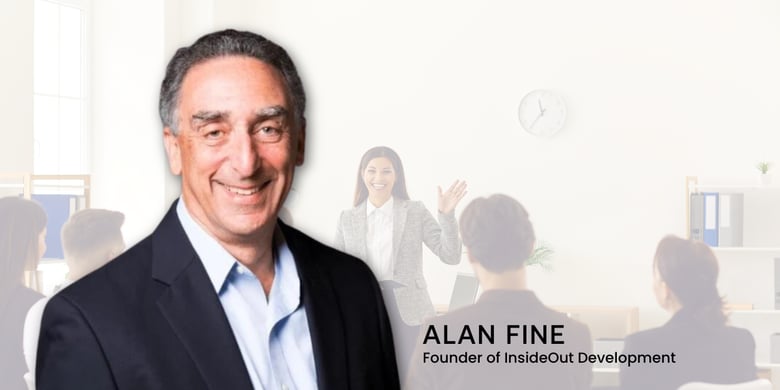The landscape of executive and leadership coaching looked very different in the 1970s and 1980s than it does today.
The term "coaching" had become popular during the 1970s, but not much groundwork apart from traditional methods of counseling was actually in place — the type of counseling specifically developed for individual, personal growth, and not as a segment of a larger workforce population.
During the 1980s, the frameworks establishing the leadership and executive coaching we know today were being built by pioneers in the field such as Alan Fine, Graham Alexander, and Sir John Whitmore.
Who Developed the GROW® Coaching Model?
 One of the most popular of the frameworks created at that time and still in use today is the GROW® Coaching methodology.
One of the most popular of the frameworks created at that time and still in use today is the GROW® Coaching methodology.
This method of executive and leadership coaching came about when the founder of InsideOut Development, Alan Fine, realized that while the traditional methods of counseling being brought into business and team environments were useful, they weren't enough to move the needle when it came to quantifiable results that businesses and executive leadership could rely on.
Fine, alongside his colleagues Alexander and Whitmore, identified gaps that many of the original models within business coaching weren't addressing. These gaps were especially evident when it came to laying the necessary foundations for success within the entire organization or team when it came to the interplay between leadership and team members.
Fine knew from his background in individual leadership coaching that for the identified gaps to be closed, a deeper understanding of the organization as a whole would be vital.
How GROW® Gained Traction
One of the first challenges was defining the term "coaching" outside of a sports context. Alan Fine began his professional coaching career as a tennis coach, and many of his initial colleagues in the executive coaching space came from the world of sports coaching as well.
These early coaches were able to successfully take individual components of a team and create synergy — the ability to get more from the combined effect of a team than the sum of their individual efforts. Some of the same techniques were easily put into practice in organizations, but there were a few that didn't translate over as easily.
By combining the development of interpersonal goals in tandem with managerial skills, and including the short- and long-term goals of the organization in the process, a new definition of executive coaching came to prominence.
While this was a good start, it wasn't enough to merely define executive and leadership coaching. What was also needed was a greater understanding that this type of coaching could provide real and lasting benefits to the organization as a whole.
Initially, the concept was poorly understood by decision-makers who were responsible for buying coaching for their business leaders. Often, executive or leadership coaching was used as a "last-ditch" effort in remediation for managers and executives who were failing to achieve key business metrics or goals.
Closing this particular gap would require bringing a usable framework to large organizations that could be implemented without putting additional stress on their working environments. The organizations would need to be well-known, respected, and leaders in their respective industries to achieve the largest ripple effect possible of this knowledge.
Alan Fine created his coaching consulting firm InsideOut Development to address this challenge head-on in 1985, bringing the synergistic concept of executive and leadership coaching to some of the largest and most diverse business and government organizations throughout the world, such as:
The Backbone of GROW®: The InsideOut Mindset®

There are four main areas of focus that Alan Fine designed for the InsideOut Mindset® Performance Wheel™: Knowledge, Focus, Faith, and Fire. All four of these components of performance must be developed together for organizations to see their goals and objectives become a reality.
Both leaders and followers should have Knowledge of the why, how, when, and what they are supposed to do. If individuals aren't sure of the role they play in the bigger picture, any attempt to increase key performance indicators (KPIs) is futile.
Without knowledge, there will be a lack of Focus, because changes in performance are always preceded by changes in what we choose to focus on.
The third component, Faith, is what we believe about ourselves and others, including both verbal and non-verbal perceptions. And while perception is not reality, perception can definitely become a person's reality, whether they are in positions of leadership or not.
Finally, Fire is the byproduct of the Focus and Faith quadrants that gives people the energy and motivation to perform.
The combination of these four key elements creates the InsideOut Mindset®, which creates exponential value for individuals and the organizations they are a part of, increasing that synergistic return on investment. These elements form the basics of what Alan Fine has developed into GROW® Coaching.
What Are the Steps of the GROW® Coaching Technique?
![[ROPS] The Invention and Innovation of GROW® Coaching_Post 2](https://insideoutdev.com/hs-fs/hubfs/%5BROPS%5D%20The%20Invention%20and%20Innovation%20of%20GROW%C2%AE%20Coaching_Post%202.png?width=800&height=356&name=%5BROPS%5D%20The%20Invention%20and%20Innovation%20of%20GROW%C2%AE%20Coaching_Post%202.png)
The basic concept of the GROW® Model is an acronym for the four components of any decision-making process: Goal, Reality, Options, and Way Forward.
- G = Goal: What increased performance looks like
- R = Reality: Barriers and supports that could impact the achievement of the goal
- O = Options: All the possibilities available to the decision-maker
- W = Way Forward: The specific action plan selected from available options
GROW® Coaching combines the GROW® Model with the Performance Wheel™, synthesized from years of practical experience from world-renowned coaches looking to drive performance in any field.
By combining these two elements of business coaching, organizations achieve an easily replicated state called "decision velocity."
Decision velocity is the ability of leadership and employees to think through their decisions efficiently so they can make informed, faster decisions, leading to effective actions that produce excellent results, all within time frames that ensure a maximum return on team members’ and leadership’s investment.
It’s Time for Your Organization to GROW®
With the GROW® Model, you can:
-
Achieve organizational goals
-
Improve employee engagement, satisfaction, retention, productivity, and performance
-
Increase revenue, profitability, and customer satisfaction
-
Unlock the skills people already have and unleash their ability to learn new skills
-
Align and empower your people to focus on the most important aspects of the business to become nimbler at capitalizing on business opportunities
Get in touch with a member of our coaching staff today to talk about solutions tailored to your organization's needs.





